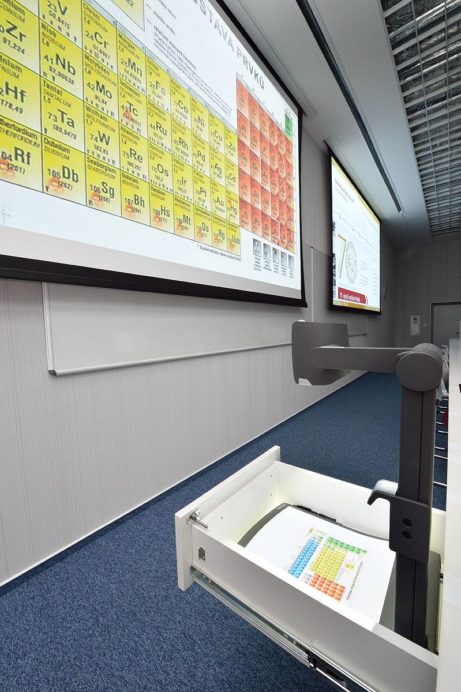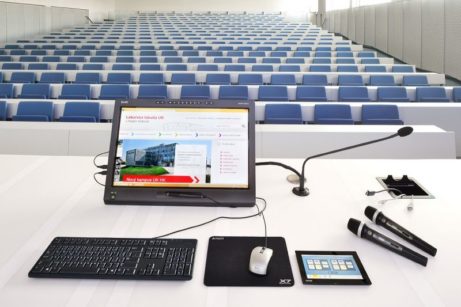MEPHARED - TEACHING AND RESEARCH CENTRE OF CHARLES UNIVERSITY IN HRADEC KRALOVE
The Faculty of Medicine of Charles University in Hradec Kralove was the first newly established university in our country after the Second World War. It was originally founded as a branch of the Faculty of Medicine of Charles University in Prague. In 1951 the branch was transformed into the Military Medical Academy. After the Academy was dissolved in 1958, the Military Medical Research and Training Institute of J. E. Purkyně was created from the military departments and the Faculty of Medicine in Hradec Králové became a full-fledged faculty of Charles University.
It provides education in the Master's degree programmes in General Medicine, Dentistry in both Czech and English and in the Bachelor's degree programme in Nursing. The faculty has become a place of study for students coming from different countries of the world: from the UK, Germany, Norway, Malaysia, USA, Ireland, India and Pakistan.
The Faculty of Pharmacy of Charles University in Hradec Králové was established in 1969. It performs an irreplaceable function in the educational structure and in the field of special scientific activities. At the beginning, teaching took place in temporary conditions at a total of 16 locations in the then regional city. Teaching was often done in block form and also took place on Saturdays and Sundays.
The faculty went through many changes. Since the academic year 1994/1995, foreign students have been studying there in English. In addition to the traditional Master's degree in Pharmacy, the Bachelor's degree programme can now be followed by a Master's degree in Medical Bioanalytics. Graduates of pharmacy and bioanalytics will find employment not only in the Czech Republic but also in other EU countries.
The management of the faculties considers it necessary to gradually move the facilities of the Faculty of Medicine and the Faculty of Pharmacy to a common campus, to connect them with each other and with other departments of the Faculty of Medicine and to anticipate the prospective establishment, activities and functions of a campus of two closely oriented (teaching and research) faculties and a university hospital.

THE TEACHING AND RESEARCH CENTRE IS THE FIRST BUILDING OF THE NEW UNIVERSITY CAMPUS
The building was inaugurated at the beginning of October 2015. The Centre is designed for teaching and research activities of four institutes and departments of the Faculty of Medicine and the Faculty of Arts. However, in terms of teaching provision, the building will be used by all students of both faculties.
The technical equipment of the building is designed with future low operating costs in mind.
AV MEDIA a.s. supplied all AV equipment for this project, i.e. equipment for the large and small lecture theatre, all seminar rooms and classrooms, as well as equipment for the Pharmacy Simulator. In line with current technical trends, fully digital distribution of AV signals was used in all rooms, ensuring perfect picture and sound.
Large lecture hall
is equipped with two widescreen projections that allow teachers to display two different images from two sources at the same time for greater clarity, e.g. a presentation and accompanying photographs or video. The projection is provided by two powerful Panasonic Full HD projectors on special Projecta electric screens with side switching surfaces with tubes built into the ceiling. Due to the requirement for high projected resolutions, which require maximally flat screens, it was necessary to choose side-off projection surfaces. When selecting the screen size for this room, it was necessary to take into account the maximum viewing distance and the room clearance (a compromise between screen size, viewing angles and distance had to be chosen). The proposed screen size of 340 × 216 cm is the maximum possible size for the height of the auditorium. Since a taller screen could not be used and according to ergonomic principles the screen should be 330 cm high, we had to add 4 more displays to cover the viewing distance of the last six rows. These are Panasonic Full HD LCD displays suspended below the ceiling on fixed ceiling brackets allowing the display to be tilted towards the viewer. Twenty built-in loudspeakers and a total of nine microphones provide an impeccable sound system for the auditorium. The large atypical lecture theatre is equipped with an interactive SMART Podium SP524 presentation display, multiple connection points, an AMX touch panel control system for easy control of AV equipment, a Wolfvision desktop visualiser and a pull-out lectern. To get quick feedback, the room is equipped with a portable voting system for 340 people. Voting participants press the answer button on the wireless controller and the voting results are instantly displayed in a presentation in the form of clear graphs. The voting results can then be saved, exported to statistics in Excel or saved as a PDF, for example.
The hall has installed a Mediasite camera and recording system for synchronised recording of the speaker and his presentation. The resulting recording of the lecture can then be made available on the school network to students for exam preparation or revision. The system also has the ability to live stream the lecture to a web player or to a data-linked smaller lecture hall.
Small lecture hall
has the same AV technology control system as well as the SMART Podium interactive presentation display and Wolfvision visualizer installed in the department. The lecture theatre is smaller and therefore has only one widescreen projection. The lecture theatre sound system is provided by nine built-in loudspeakers and a set of microphones. The auditorium is planned to accommodate two cameras for recording, transmission and possibly video conferencing purposes. There is also a voting system for 110 participants. Both lecture halls are equipped with induction loop for the hearing impaired.
Seminar rooms, classrooms and laboratories.
In these rooms, one central projection is designed with an aspect ratio of 16:10 using a Full HD projector on a Projecta electric screen built into the ceiling. The screen is sized to maximise viewing distances in the hall. The projection is complemented by a stereo sound system optimised for spoken word. All departments are equipped with connection points for more comfortable work of the lecturers, interactive presentation display SMART Podium SP524, which allows to control the presentation by touch, write notes directly into it or mark important points. Everything the presenter creates on the touch panel is displayed simultaneously on the installed screens. Each room also has a push-button control system for controlling AV equipment from one location in the department. Select rooms also have a Wolfvision visualizer for scanning printed documents, transparencies or smaller objects.
The library and day room have 50" LED TVs with integrated WIDI technology for wireless transmission of images from laptops to the TV.
Practical room of students
are 2 separate rooms that can be combined into one large room by folding a mobile partition. It serves as a practical laboratory area and the teachers have two widescreen Full HD projections on built-in electric screens where they project teaching information to the students. The sound system is provided by two sets of loudspeakers. Both rooms have a wall-mounted built-in connection point for a presentation computer. The SMART Podium interactive presentation display can also be found here, allowing the presentation to be controlled using an electronic pen or notes to be added directly to the projected image.
Pharmacy simulator
is a room where future pharmacists can try out a real situation in a pharmacy. There are two panoramic and zoomable Axis cameras, including software to manage and control them, which monitor the student's progress in dispensing medications and providing information to patients. The captured image is transmitted to the adjacent so-called Assessment Room where on an interactive SMART Board 6065 display with integrated speakers and mini PC, the image from the IP cameras is displayed and discussed by the lecturer with the students with the possibility of direct plotting and annotation.
Contact us









